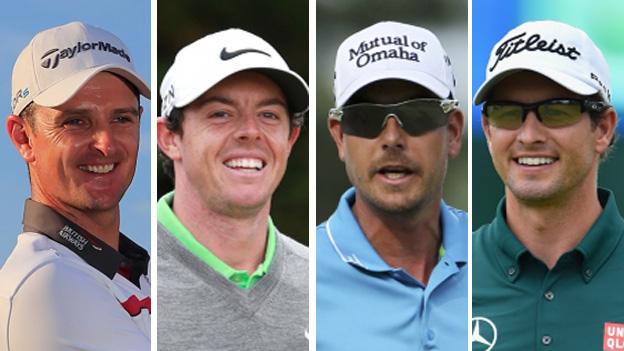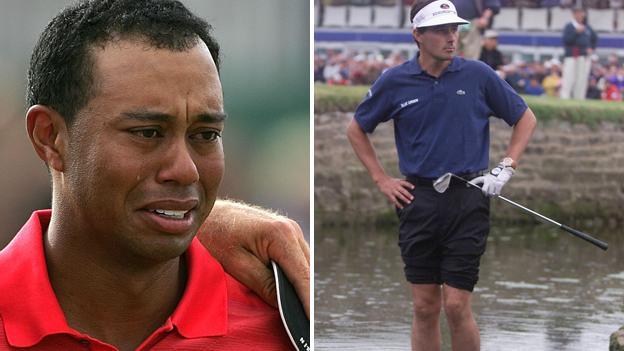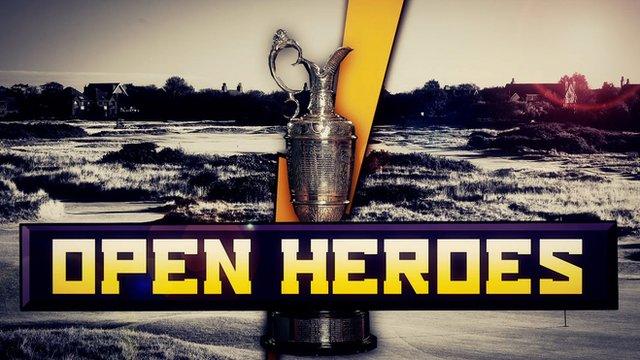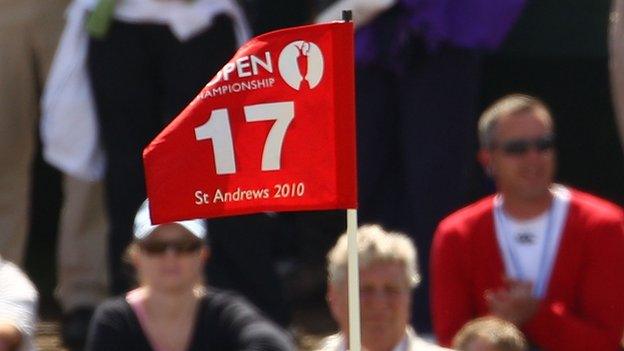The Open Championship A-Z
- Published
The story of Mickelson's winning round
A is for Americans. Despite all the talk about links golf being a British game, US players have a good record in the Open. Sheer numbers could account for that, of course, but Americans have won eight Opens stretching back to 2000 (three by Tiger Woods) and 12 of the last 20, including defending champion Phil Mickelson.
B is for bunkers. There are 82 of the little blighters at Royal Liverpool, 13 down on 2006 when the Open was last held at Hoylake. "Whether you hit a driver or an iron off the tee, the bunkers are to be avoided at all costs," says Royal Liverpool head pro John Heggarty. Also for Ballesteros. The iconic Spaniard who won the Open in 1979, 1984 and 1988 but sadly died from a brain tumour aged 54 in May 2011.
C is for Claret Jug. From which the winner will be drinking on Sunday evening. Officially called the "Golf Champion Trophy", it was first awarded in 1872. The original is displayed in the Royal & Ancient clubhouse in St Andrews. The current Jug was first awarded in 1928. The winner takes it home for a year, but gets a replica for keeps. Phil Mickelson confessed to drinking from a £12,000 bottle of 1990 Domaine de la Romanee Conti - a red burgundy - in the Claret Jug last year. It seems more popular among family and friends than the Masters Green Jacket. "There's not really much you can do with the jacket, other than pull on the lapels," said Mickelson.
D is Debut. Nine players have won the Open at their first attempt but none since Ben Curtis at Royal St George's in 2003. D could also be for disaster. Ask Adam Scott about his four-bogey finish to cede the 2012 title to Ernie Els, or consult Jean van de Velde about his nightmare at Carnoustie in 1999.
E is for Englishman. The last to win the Open was Nick Faldo at Muirfield in 1992. Sir Nick was second to Greg Norman the following year and since then Lee Westwood (2010) and Ian Poulter (2008) have also finished second, while Mark James, Steven Bottomley, Faldo, Justin Rose, Chris Wood and Paul Casey, as well as Westwood and Poulter again, have all had top-four finishes.
F is for Faldo. Sir Nick won three Opens in all - at Muirfield in 1987 and 1992 and St Andrews in 1990 - and remains Britain's most successful golfer with six majors to his name. More a TV golf analyst in the US these days, Faldo made a playing return at the Open last year and will stride Hoylake's fairways again this week, celebrating his 57th birthday on Friday.
G is for Grand Slam. The holy grail of winning all four of golf's majors in a season. In the modern era, since the Masters was introduced in 1934, no player has achieved the feat, though Tiger Woods held all four at the same time over tow calendar years in 2000-2001. Five players have achieved the career Grand Slam of all winning four titles at some stage - Jack Nicklaus, Woods, Ben Hogan, Gary Player, Gene Sarazen. Of current players, Phil Mickelson is closest with just the US Open to go after his Open win at Muirfield last year.
Cotter's course guide
H is for the Hoylake. Or Royal Liverpool, to give it its proper name,, a small, flat patch of links on the north-west tip of the Wirral peninsula. The club was founded in 1869 on the racecourse of the Liverpool Hunt Club, and received the "Royal" designation in 1871. It has hosted 11 previous Opens but was restored to the rota in 2006 after a gap of 39 years. Legendary scribe Bernard Darwin wrote: , external""Hoylake, blown upon by mighty winds, breeder of mighty champions."
I is for Inclement as in weather. The elements are a links course's natural defence and part and parcel of playing in the Open. Also for iron. Tiger Woods famously hit irons off most tees and a driver only once when he won in 2006. The low two-iron stinger was his go-to shot and most players will have put a two-iron in the bag specifically for Hoylake.
J is for Jack. As in Nicklaus. Always was, always will be. Still the greatest golfer of all time with 18 majors, including three Opens (1966, 1970, 1978). Nicklaus was also second seven times in the Open - he was second to Robert de Vicenzo at Royal Liverpool in 1967. Also Jacklin, Tony. The last Englishman to win an Open in England (in 1969).
K is for K. As in £975K goes to the winner of the Open. Not bad for four days of bashing and stroking a white ball around a field. Second gets £560K so two feet of Wirral turf, in the form of a missed putt, could be costly. The last man to squeeze inside the cut will trouser between £9,000 and £12,400, depending on the number of qualifiers. Miss the weekend and you're looking at £3,800 or less.
L is for links. The term for a type of golf course on coastal duneland, often reclaimed from the sea, and in days gone by deemed unsuitable for arable farming. The Open is always played on a links course. Hoylake is the second oldest links in England behind Devon's Westward Ho!
M is for Mickelson. Phil is the defending champion after clinching a spectacular first Open title and fifth major at Muirfield last year. The left-hander finally adapted his flamboyant game to the intricacies of links golf and landed the third leg of a career Grand Slam of all four majors. "It validates me as a complete player," he says. Only the US Open - in which he has been runner-up a record six times - eludes him.
Open 2014: A look back at The Open's 'heroes'
N is for Next. The 2015 Open will be back at the home of golf, St Andrews, Fife, followed by Royal Troon in 2016, Royal Birkdale in 2017 and Carnoustie in 2018. Northern Ireland's Royal Portrush could well make a reappearance on the Open rota for the first time since 1951 in 2019.
O is for Open. Obviously. And don't call it "British". The oldest major, first contested in 1860 at Prestwick. This year marks the 143rd edition. O is also for oldest winner, which is Old Tom Morris at 46 years and 99 days in 1867. Since the Second World War, Roberto de Vicenzo at 44 years 93 days wins the award for his 1967 victory. The last three champions - Phil Mickelson, Ernie Els and Darren Clarke have all been over 40.
P is for Player. Specifically, Gary. The South African won the first of his three Opens as a 23-year-old at Muirfield in 1959 and added Claret Jugs in 1968 and 1974. "To me the Open Championship is the greatest tournament in the world," he says. Player, now 78, won nine majors in all and was part of the "Big Three" with Jack Nicklaus and Arnold Palmer.
Q is for qualifying. More than 2,500 golfers play qualifiers across five continents over seven months for the chance to compete in the 156-man field at the Open Championship. Liverpool resin factory worker John Singleton embodies the dream after winning a 72-man qualifier at Hillside to book his place at Hoylake. "It's every golfers' dream to play in the Open and now it's happening to me on my doorstep," he said. "It's a bit overwhelming."
R is for Rose as in Justin. Hoping to emulate Phil Mickelson by winning the Open and the Scottish Open in consecutive weeks. Also won on his last start in America and the form player in world golf. Became the first Englishman to win the US Open since Tony Jacklin in 1970 when he clinched maiden major at Merion last year. He 'rose' to prominence when he chipped in en route to a fourth-place finish , externalas a 17-year-old amateur at Royal Birkdale in 1998.
How Adam Scott lost the 2012 Open
S is for Scott. Adam Scott. The Australian, who turned 34 on Wednesday, is the world number one and many people's idea of the winner at Hoylake this week. He's been second and third in the last two editions, including that infamous collapse from four ahead with four to play at Royal Lytham in 2012. But a Masters title last year has given him the belief - the only ingredient missing. S is also for Scots. Paul Lawrie is still the last to win the Open, back in 1999, though Colin Montgomerie has won two majors on the US senior circuit this year.
T is for Tom as in Watson. The American won on his Open debut at Carnoustie in 1975 and went on to win five times, despite admitting he hated links golf to start with. Could have made it six Claret Jugs, too, only to be foiled in a play-off by countryman Stewart Cink at the age of 59 at Turnberry in 2009. , external
U is for under as in par. Tiger Woods holds the major record with 19 under, set at St Andrews in 2000. He ended two shots clear at 18 under when he won at the fast-running Royal Liverpool in 2006.
V is for the venues. All 14 of them, which have hosted the 142 previous Opens stretching back to 1860. They are: St Andrews (27), Prestwick (24), Muirfield (16), Royal St George's (14), Royal Liverpool (11), Royal Lytham & St Annes (10), Royal Birkdale (9), Royal Troon (8), Carnoustie (7), Musselburgh (6), Turnberry (4), Royal Cinque Ports (2), Prince's (1), Royal Portrush (1). V is also for Harry Vardon, who has won the most Open titles with six between 1896 and 1914.
W is for Woods. Tiger, of that variety, is still chasing that elusive 15th major title and first since 2008. The 38-year-old won the last of his three Opens at Hoylake in 2006, but despite missing a chunk of this season for back surgery, Woods is only interested in one result this week. "First," he said.
X is for xeric. Which means "containing little moisture, very dry". So either the yellowing links of an iconic sun-bleached Open, such as Hoylake in 2006, or the mouths of the leaders playing the last few holes about tea time on Sunday.
Y is for Young Tom Morris. The youngest ever Open champion at 17 years, five months and three days when he won at Prestwick in 1868. Since 1900, the youngest winner has been Seve Ballesteros, who was 22 years, three months and 12 days when he won at Royal Lytham in 1979.
Z is for zero hour. The first group - David Howell, David Duval and Robert Karlsson - will get the 143rd Open Championship under way at 0625 BST on Thursday. It's also for zenith - for many, winning the Open will be the high point of their career.
- Published16 July 2014

- Published16 July 2014

- Published16 July 2014

- Published14 July 2014
